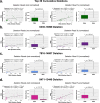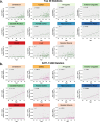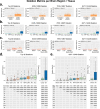Common mitochondrial deletions in RNA-Seq: evaluation of bulk, single-cell, and spatial transcriptomic datasets
- PMID: 38368460
- PMCID: PMC10874445
- DOI: 10.1038/s42003-024-05877-4
Common mitochondrial deletions in RNA-Seq: evaluation of bulk, single-cell, and spatial transcriptomic datasets
Abstract
Common mitochondrial DNA (mtDNA) deletions are large structural variants in the mitochondrial genome that accumulate in metabolically active tissues with age and have been investigated in various diseases. We applied the Splice-Break2 pipeline (designed for high-throughput quantification of mtDNA deletions) to human RNA-Seq datasets and describe the methodological considerations for evaluating common deletions in bulk, single-cell, and spatial transcriptomics datasets. A robust evaluation of 1570 samples from 14 RNA-Seq studies showed: (i) the abundance of some common deletions detected in PCR-amplified mtDNA correlates with levels observed in RNA-Seq data; (ii) RNA-Seq library preparation method has a strong effect on deletion detection; (iii) deletions had a significant, positive correlation with age in brain and muscle; (iv) deletions were enriched in cortical grey matter, specifically in layers 3 and 5; and (v) brain regions with dopaminergic neurons (i.e., substantia nigra, ventral tegmental area, and caudate nucleus) had remarkable enrichment of common mtDNA deletions.
© 2024. The Author(s).
Conflict of interest statement
The authors declare no competing interests.
Figures








References
Publication types
MeSH terms
Substances
Grants and funding
LinkOut - more resources
Full Text Sources
Molecular Biology Databases

